英文文献
- 格式:doc
- 大小:41.00 KB
- 文档页数:7
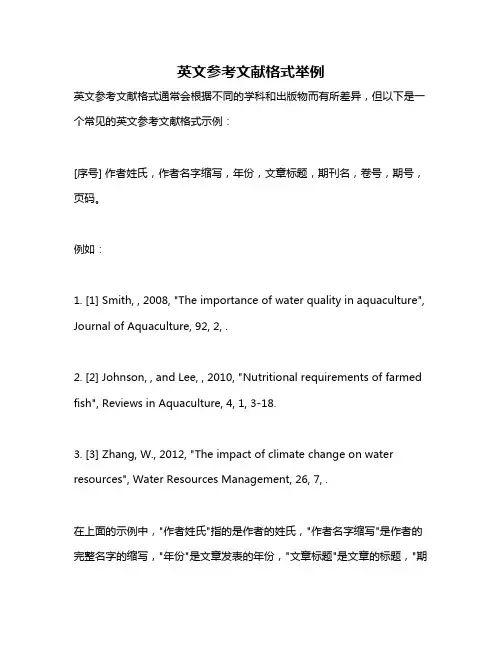
英文参考文献格式举例
英文参考文献格式通常会根据不同的学科和出版物而有所差异,但以下是一个常见的英文参考文献格式示例:
[序号] 作者姓氏,作者名字缩写,年份,文章标题,期刊名,卷号,期号,页码。
例如:
1. [1] Smith, , 2008, "The importance of water quality in aquaculture", Journal of Aquaculture, 92, 2, .
2. [2] Johnson, , and Lee, , 2010, "Nutritional requirements of farmed fish", Reviews in Aquaculture, 4, 1, 3-18.
3. [3] Zhang, W., 2012, "The impact of climate change on water resources", Water Resources Management, 26, 7, .
在上面的示例中,"作者姓氏"指的是作者的姓氏,"作者名字缩写"是作者的完整名字的缩写,"年份"是文章发表的年份,"文章标题"是文章的标题,"期
刊名"是期刊的名称,"卷号"是期刊的卷号,"期号"是期刊的期号,"页码"是文章的起始页码。
请注意,这只是一个示例,具体的格式可能会因学科、出版物或学术机构的要求而有所不同。
因此,在撰写英文参考文献时,最好查阅所投期刊或出版物的具体格式要求,以确保正确引用文献。
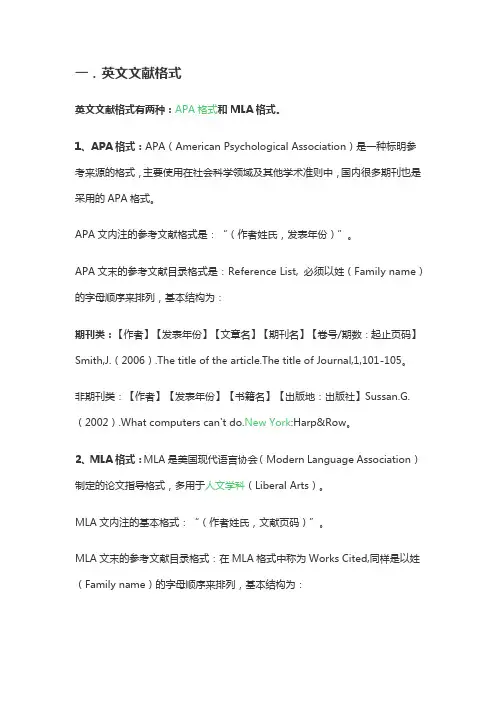
一.英文文献格式英文文献格式有两种:APA格式和MLA格式。
1、APA格式:APA(American Psychological Association)是一种标明参考来源的格式,主要使用在社会科学领域及其他学术准则中,国内很多期刊也是采用的APA格式。
APA文内注的参考文献格式是:“(作者姓氏,发表年份)”。
APA文末的参考文献目录格式是:Reference List, 必须以姓(Family name)的字母顺序来排列,基本结构为:期刊类:【作者】【发表年份】【文章名】【期刊名】【卷号/期数:起止页码】Smith,J.(2006).The title of the article.The title of Journal,1,101-105。
非期刊类:【作者】【发表年份】【书籍名】【出版地:出版社】Sussan.G.(2002).What computers can't do.New York:Harp&Row。
2、MLA格式:MLA是美国现代语言协会(Modern Language Association)制定的论文指导格式,多用于人文学科(Liberal Arts)。
MLA文内注的基本格式:“(作者姓氏,文献页码)”。
MLA文末的参考文献目录格式:在MLA格式中称为Works Cited,同样是以姓(Family name)的字母顺序来排列,基本结构为:期刊类:【作者】【“文章名”】【期刊名】【卷号或期数】【发表年份】起止页码】Nwezeh,C.E.“The Comparative Approachto Modern African Literature.”Year book of General and Comparative Literature 28(1979):22。
非期刊类:【作者】【书籍名】【出版地:出版社】【发表年份】Winfield,Richard w in Civil Society.Madison:U of Wisconsin P,1995。
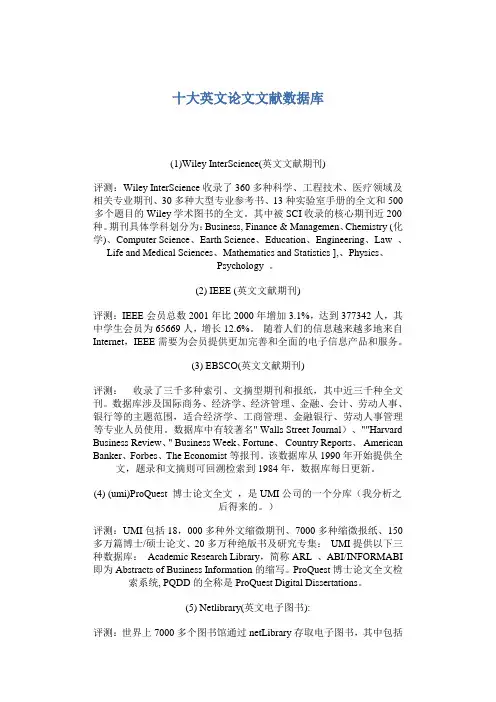
十大英文论文文献数据库(1)Wiley InterScience(英文文献期刊)评测:Wiley InterScience收录了360多种科学、工程技术、医疗领域及相关专业期刊、30多种大型专业参考书、13种实验室手册的全文和500多个题目的Wiley学术图书的全文。
其中被SCI收录的核心期刊近200种。
期刊具体学科划分为:Business, Finance & Managemen、Chemistry (化学)、Computer Science、Earth Science、Education、Engineering、Law、Life and Medical Sciences、Mathematics and Statistics ],、Physics、Psychology。
(2) IEEE (英文文献期刊)评测:IEEE会员总数2001年比2000年增加3.1%,达到377342人,其中学生会员为65669人,增长12.6%。
随着人们的信息越来越多地来自Internet,IEEE需要为会员提供更加完善和全面的电子信息产品和服务。
(3) EBSCO(英文文献期刊)评测:收录了三千多种索引、文摘型期刊和报纸,其中近三千种全文刊。
数据库涉及国际商务、经济学、经济管理、金融、会计、劳动人事、银行等的主题范围,适合经济学、工商管理、金融银行、劳动人事管理等专业人员使用。
数据库中有较著名" Walls Street Journal)、""Harvard Business Review、" Business Week、Fortune、Country Reports、American Banker、Forbes、The Economist等报刊。
该数据库从1990年开始提供全文,题录和文摘则可回溯检索到1984年,数据库每日更新。
(4) (umi)ProQuest博士论文全文,是UMI公司的一个分库(我分析之后得来的。
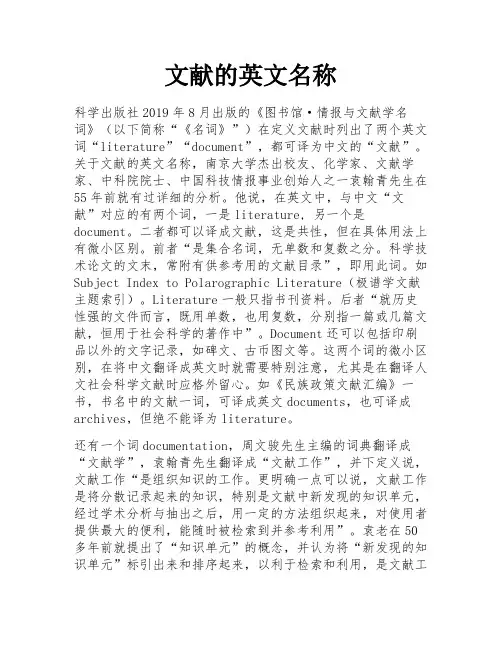
文献的英文名称科学出版社2019年8月出版的《图书馆·情报与文献学名词》(以下简称“《名词》”)在定义文献时列出了两个英文词“literature”“document”,都可译为中文的“文献”。
关于文献的英文名称,南京大学杰出校友、化学家、文献学家、中科院院士、中国科技情报事业创始人之一袁翰青先生在55年前就有过详细的分析。
他说,在英文中,与中文“文献”对应的有两个词,一是literature, 另一个是document。
二者都可以译成文献,这是共性,但在具体用法上有微小区别。
前者“是集合名词,无单数和复数之分。
科学技术论文的文末,常附有供参考用的文献目录”,即用此词。
如Subject Index to Polarographic Literature(极谱学文献主题索引)。
Literature一般只指书刊资料。
后者“就历史性强的文件而言,既用单数,也用复数,分别指一篇或几篇文献,恒用于社会科学的著作中”。
Document还可以包括印刷品以外的文字记录,如碑文、古币图文等。
这两个词的微小区别,在将中文翻译成英文时就需要特别注意,尤其是在翻译人文社会科学文献时应格外留心。
如《民族政策文献汇编》一书,书名中的文献一词,可译成英文documents,也可译成archives,但绝不能译为literature。
还有一个词documentation,周文骏先生主编的词典翻译成“文献学”,袁翰青先生翻译成“文献工作”,并下定义说,文献工作“是组织知识的工作。
更明确一点可以说,文献工作是将分散记录起来的知识,特别是文献中新发现的知识单元,经过学术分析与抽出之后,用一定的方法组织起来,对使用者提供最大的便利,能随时被检索到并参考利用”。
袁老在50多年前就提出了“知识单元”的概念,并认为将“新发现的知识单元”标引出来和排序起来,以利于检索和利用,是文献工作的重点。
“文献中的知识单元实质上就是所含的情报”。
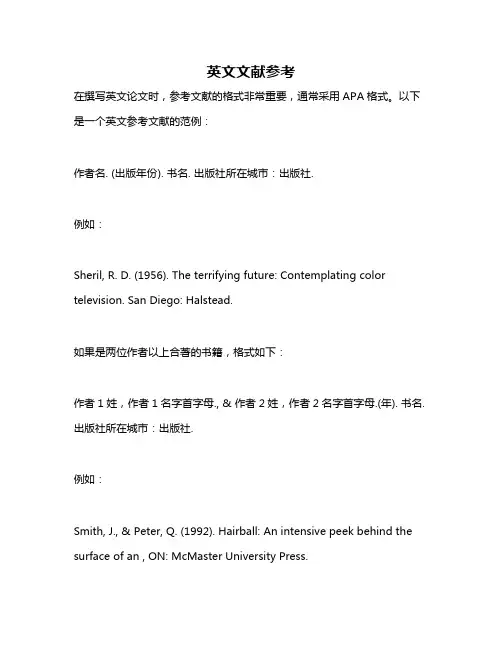
英文文献参考
在撰写英文论文时,参考文献的格式非常重要,通常采用APA格式。
以下是一个英文参考文献的范例:
作者名. (出版年份). 书名. 出版社所在城市:出版社.
例如:
Sheril, R. D. (1956). The terrifying future: Contemplating color television. San Diego: Halstead.
如果是两位作者以上合著的书籍,格式如下:
作者1姓,作者1名字首字母., & 作者2姓,作者2名字首字母.(年). 书名. 出版社所在城市:出版社.
例如:
Smith, J., & Peter, Q. (1992). Hairball: An intensive peek behind the surface of an , ON: McMaster University Press.
如果是文集中的文章,格式如下:
作者名.(年). 文章题目. 期刊名(斜体). 第几期,页码.
例如:
Smith, J. (2007). The role of technology in education. Journal of Educational Technology, 45(3), 56-67.
如果是月刊杂志中的文章,格式如下:
作者名.(年). 文章题目. 月刊杂志名(斜体). 第几期,页码.
例如:
Jones, L. (2008). The impact of social media on society. American Journal of Social Media, 5(6), .。
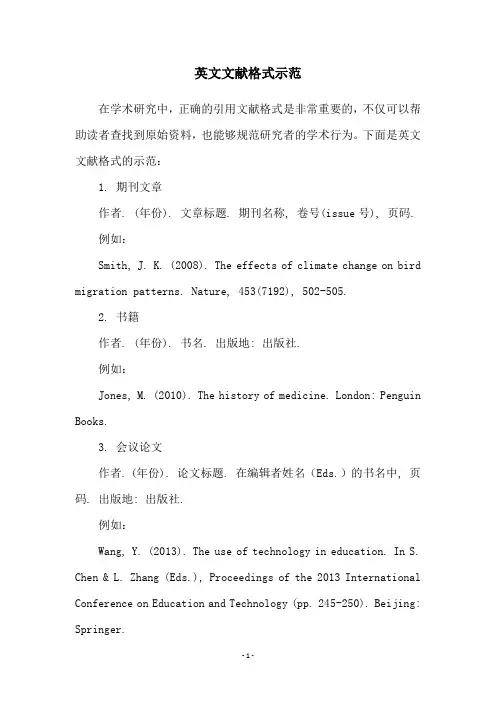
英文文献格式示范在学术研究中,正确的引用文献格式是非常重要的,不仅可以帮助读者查找到原始资料,也能够规范研究者的学术行为。
下面是英文文献格式的示范:1. 期刊文章作者. (年份). 文章标题. 期刊名称, 卷号(issue号), 页码.例如:Smith, J. K. (2008). The effects of climate change on bird migration patterns. Nature, 453(7192), 502-505.2. 书籍作者. (年份). 书名. 出版地: 出版社.例如:Jones, M. (2010). The history of medicine. London: Penguin Books.3. 会议论文作者. (年份). 论文标题. 在编辑者姓名(Eds.)的书名中, 页码. 出版地: 出版社.例如:Wang, Y. (2013). The use of technology in education. In S. Chen & L. Zhang (Eds.), Proceedings of the 2013 International Conference on Education and Technology (pp. 245-250). Beijing: Springer.4. 网络资源作者. (年份). 文章标题. 来源. 网址.例如:Smith, J. K. (2015). The impacts of air pollution on human health. Environmental Health Perspectives.https:///pmc/articles/PMC4483703/ 以上就是英文文献格式的示范,希望对大家的学术研究有所帮助。
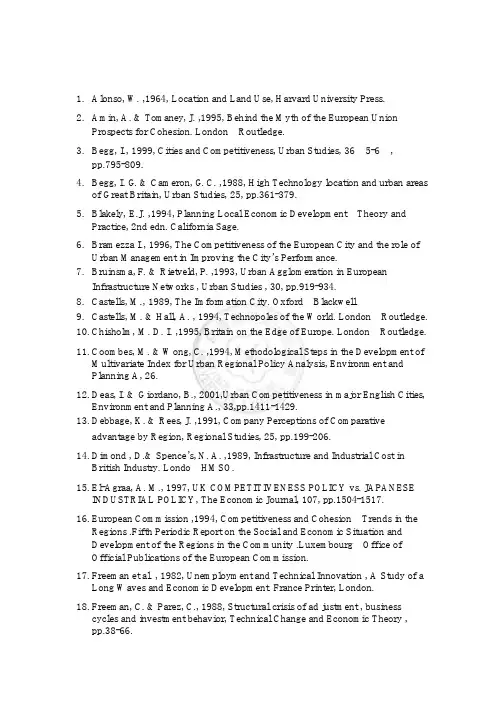
1.Alonso, W. ,1964, Location and Land Use, Harvard University Press.2.Amin, A. & Tomaney, J. ,1995, Behind the Myth of the European Union¡GProspects for Cohesion. London¡G Routledge.3.Begg, I., 1999, Cities and Competitiveness, Urban Studies, 36¡]5-6¡^,pp.795-809.4.Begg, I. G. & Cameron, G. C. ,1988, High Technology location and urban areasof Great Britain, Urban Studies, 25, pp.361-379.5.Blakely, E.J. ,1994, Planning Local Economic Development¡G Theory andPractice, 2nd edn. California Sage.6.Bramezza I., 1996, The Competitiveness of the European City and the role ofUrban Management in Improving the City’s Performance.7.Bruinsma, F. & Rietveld, P. ,1993, Urban Agglomeration in EuropeanInfrastructure Networks , Urban Studies , 30, pp.919-934.8.Castells, M., 1989, The Imformation City. Oxford¡G Blackwell.9.Castells, M. & Hall, A. , 1994, Technopoles of the World. London¡G Routledge.10.Chisholm, M. D. I. ,1995, Britain on the Edge of Europe. London¡G Routledge.11.Coombes, M. & Wong, C. ,1994, Methodological Steps in the Development ofMultivariate Index for Urban Regional Policy Analysis, Environment andPlanning A, 26.12.Deas, I. & Giordano, B., 2001,Urban Competitiveness in major English Cities,Environment and Planning A., 33,pp.1411-1429.13.Debbage, K. & Rees, J. ,1991, Company Perceptions of Comparativeadvantage by Region, Regional Studies, 25, pp.199-206.14.Dimond , D.& Spence’s, N. A. ,1989, Infrastructure and Industrial Cost inBritish Industry. Londo¡G HMSO.15.El-Agraa, A. M., 1997, UK COMPETITIVENESS POLICY vs. JAPANESEINDUSTRIAL POLICY, The Economic Journal, 107, pp.1504-1517.16.European Commission ,1994, Competitiveness and Cohesion¡G Trends in theRegions .Fifth Periodic Report on the Social and Economic Situation andDevelopment of the Regions in the Community .Luxembourg¡G Office ofOfficial Publications of the European Commission.17.Freeman et al. , 1982, Unemployment and Technical Innovation , A Study of aLong Waves and Economic Development. France Printer, London.18.Freeman, C. & Parez, C., 1988, Structural crisis of ad justment , businesscycles and investment behavior, Technical Change and Economic Theory ,pp.38-66.19.Frenke, A., 2000, Can Regional Policy Affect Firms, Innovation Potential inLagging Regions, Regional Science, 34,pp.315-341.20.Hall, P. et al., 1987, Western Sunrise¡G The Genesis and Growth of Britain’sMajor High Tech Corridor. Hemel Hempstead¡G Allan and Unwin.21.Hatfield, L., 2002, Performance Effect of Alternative Joint Venture ResourceResponsibility Structures , Journal of Business Venturing ,17, pp.343-364. 22.Herrschel, T., 1995, Local Policy Restructuring¡G A Comparative Assessment ofPolicy Responses in England and Germany, Area, 27, pp.228-241.23.HM. Government, 1993, Competitiveness Helping Business to Win. London¡GHMSO.24.Howells, J. & Green, A. ,1988, Technological Innovations, Structural Changeand Location in UK Services. Aldershot¡G Avebury.25.IMD., 2002, The World Competitiveness Yearbook.26.James, S., 2002, Knowledge Spillovers and Reasons for the Concentration ofInnovation SMEs. , Urban Studies, 39¡q5-6¡r,pp.885-902.27.John, R.B.,1997,Small and Medium-sized Enterprises , Business Link andNew Knowledge Workers, Policy Studies, 18¡]1¡^,pp.67-80.28.Kerlinger, F. N., 1986, Foundations of Behavioral Research, Harcourt BraceJovanovich Publishing, 1986.29.Kresl, K. P. & Singh, B., 1999, Competitiveness and Urban Economy, UrbanStudies ,36¡]5-6¡^,pp.791-793.30.Krugman, P., 1991a, Increasing Returns and Economic Geography , Journal ofPolitical Economy, 99, pp.483-499.31.Krugman, P., 1991b, The Geography of Trade. Cambridge, Ma¡G MIT Press.ll, S.,2001, Competitiveness Indices and Developing Countries ¡G AnEconomic Evaluation of the Global Competitiveness Report”, WorldDevelopment, 29¡q9¡r, pp.1501-1525.33.Malecki, E. J., 2002 ,Hard and Soft Networks for Urban Competitiveness,Urban Studies,39¡]5-6¡^,pp.929-945.34.Marshall, J. N. & Alderman, N. & Thwaites, A.T. ,1992,Civil ServicesRelocation and the English Regions , Regional Studies ,25, pp.499-510.35.Massey, D. ,1995, The Spatial Division of Labor¡G Social Structures andGeography of Production. London¡G Macmillan.36.Nijkamp, P. ,1986, Infrastructure and regional development¡G amultidimensional policy analysis , Empirical Economics , 11 , pp.1-21.anization for Economic Cooperation and Development , OECD .,1997,TheOECD List of Social Indicators¡A The OECD Social Indicator DevelopmentProgram , 538.Oughton, C., COMPETITIVENESS POLICY IN THE 1990s , The EconomicJournal, 107,pp.1486-1503.39.Porter, M.E.,2000,Location, Competition, and Economic Development:Local Cluster in a Global Economy, Economic DevelopmentQuarterly,14,pp.15-34.40.Pyke, F. & Sengenberger, W., 1992, Industrial District and Local EconomicRegeration. Geneva¡G International Institute for Labor Studies.41.Rapkin, D. & Strand, D., 1995, Competitiveness¡G useful concept , politicalslogan or dangerous obsession, in National Competitiveness in a GlobalEconomy Eds. D. Rapkin, W. Avery¡qLynne Rienner, London¡r,pp.1-30. 42.Schumpeter, J. A. ,1934, The Theory of Economic Development ,trans. by R.Opie. Cambridge , Ma¡G Harvard Universuty Press.43.Steiner ,1990, ‘Good’ and ‘Bad’ Regions¡H Criteria to Evaluate RegionalPerformance in face of an enforced internationlisation on the Europeaneconomy, Build Environment, 16(1), pp.52-68.44.Sylwester, S.,2001 ,R&D and Economic Growth, Knowledge, Technology, &Policy, 13¡q4¡r,pp.71-84.45.Tainer E.M., 1998,”Using Economic Indicators to Improve InvestmentAnalysis”.46.Taylor , J. ,1993, An Analysis of the Factors Determining the Geographicaldistribution of Japanese manufacturing Investment in the UK 1984-1991,Urban Studies , 30, pp.1209-1224.47.Townroe, P. ,1976, Planning Industrial Location . London¡G Leonard Hill Books.48.Wong, C., 2002,“Developing Indicators to Inform Local EconomicDevelopment in England”, Urban Studies , 39¡]10¡^, pp.1833-1863.49.World Economic Forum¡]WEF¡^,2002, Global Competitiveness Report50.¤ý½r·O¡A2001¡A³Ð·sªºªÅ¶¡¡Ð¥ø·~¶°¸s»P°Ï°ìµo®i¡C51. ¥@¬ÉÄvª§¤O¦~³ø¡A2000¡A·ç¤h¬¥®á°ê»ÚºÞ²z¾Ç°|IMD¡C52. ¥ª®m¼w¡B¤×±Ó§g¡A2001¡A°ê®a¬ì§ÞÄvª§¤O«ü¼Ð¤§¬ã¨s¡A¥xÆW¸gÀÙ¬ã¨s°|¡C53. ¦¶¶³ÄP¡AªL¬ü¸©¡A2001¡A±q WEF¥þ²yÄvª§¤O³ø§i¬Ý¥xÆW¤§Ävª§¤O¡C54. ¬IÂE§Ó¡A2000¡A¦a°ÏÄvª§¤O«ü¼ÐÅé¨t«Øºc¤§¬ã¨s¡A¦æ¬F°|°ê®a¬ì¾Ç©e-û·|55. §dÀٵءA1994¡A¥_°ª¨â¥«ª§¿ì¨È¹B¨Æ«áªº¬Ù«ä¡X´Á«Ý³£¥««Ø¥ß¨}µ½ªºÄvª§¾÷¨î¡A°ê®a¬Fµ¦Âù¤ë¥Z¡A²Ä88´Á¡A-¶14-15¡C56. ©P¤å½å¡A1997¡A¦hÅܶq²Î-p¤ÀªR¡C57. ©ó¥®µØ¡B±i¯q¸Û¡A2000¡A¥ÃÄòµo®i«ü¼Ð¡A°ê¥ß¥xÆW¤j¾ÇÀô¹Ò¤uµ{¾Ç¬ã¨s©Ò¡C58. §Å-Z¿K¡A2002¡A°Ï°ì³Ð·s¨t²ÎÆ[ÂI¤U¤¤¥xÆWºë±K¾÷±ñ²£·~³Ð·s¤§¬ã¨s¡AªF®ü¤j¾Ç¤u·~¤uµ{¾Ç¨tºÓ¤h½×¤å¡C59. ©ÐµL¬È¡B¤ý¨qªv¡A2001¡A²£·~Ävª§¤O½×¡A¤W®ü¸gÀÙ¡A-¶27-31¡C60. ªL¨Î¾ì¡A2002¡A¨|¦¨¤¤¤ß¼vÅT¼t°Ó³Ð·s¬¡°Ê¦¨®Ä¤§¬ã¨s¡A¥xÆW¤j¾Ç«Ø¿v»P«°¶m¬ã¨s©ÒºÓ¤h½×¤å¡C61. «J§B·ì¡A2001¡A³£¥«¸gÀçºÞ²zÁZ®Äµû¶q¨t²Î¤§¬ã¨s¡A°ê¥ß¦¨¥\¤j¾Ç³£¥«-p¹º¾Ç¨tºÓ¤h½×¤å62. ®}¼zªâ¡A1999¡A¥HÆp¥Û¼Ò¦¡«Ø¥ß°ê»Ú´ä¤fÄvª§¤Oµû¦ô·Ç«h¤§¬ã¨s¡A¥æ³q¤j¾Ç¹B¿é»PºÞ²z¾Ç¨tºÓ¤h½×¤å¡C63. ³¯°¶§Ó¡A1994¡A¥i¤Î©Ê»P°Ï°ìµo®i¢w¥H¥xÆW¦a°Ï¦è³¡¹B¿é¨«´Y¬°¨Ò¡A¤¤¿³¤j¾Ç³£¥«-pµe¬ã¨s©ÒºÓ¤h½×¤å¡C64. ³¯¥¿¨k¡BÃÓ¤j¯Â¡A1998¡A°ê®aÄvª§¤O¡B²£·~Ävª§¤O»P¼t°ÓÁZ®Ä-¨Ì¾Ú¥@¬ÉÄvª§¤O³ø¾É»P PorterÆp¥Û¼Ò¦¡¬°°ò¦¤§¹êÃÒ¬ã¨s¡A¥ø·~ºÞ²z¾Ç³ø¡A43´Á¡A -¶73-106¡C65. ³¯«a¦ì¡A2001¡A«°¥«Ävª§Àu¶Õµû¶q¨t²Î¤§¬ã¨s¡A°ê¥ß¦¨¥\¤j¾Ç¼Æ-p¹º¬ã¨s©Ò³Õ¤h½×¤å¡C66. ³¯¾åÁn¡A2001¡A²£·~Ävª§¤Oªº´ú«×»Pµû¦ô¡A¤W®ü¸gÀÙ¡A-¶45-47¡C67. ³¯Äפå¡A2000¡A¥xÆW¦a°Ï°]¬F¤£§¡»P°Ï°ìµo®i¤§¬ã¨s¡A¥x¥_¤j¾Ç°]¬F¾Ç¨tºÓ¤h¯ZºÓ¤h¾Ç¦ì½×¤å¡C68. ±i¥@¾±¡A2002¡A¦a²z¸s»E¤º¼t°Ó¤§ºôµ¸Ãö«Y¹ï¨äÄvª§¤O¼vÅT¤§¬ã¨s¡Ð·s¦Ë¬ì¾Ç¶é°Ï¤§¹êÃÒ¡A´Â¶§¬ì§Þ¤j¾Ç¥ø·~ºÞ²z¨tºÓ¤h½×¤å¡C³\®Ñ»Ê¡A2000¡A²£·~°ê»ÚÄvª§¤O¤§µo®i¤Î¼vÅT¦]¯À¤ÀªR¡X°ê®aÄvª§¤OÆ[ÂI¡A°ê¥ß¥xÆW¤j¾Ç°Ó¾Ç¬ã¨s©Ò³Õ¤h¾Ç¦ì½×¤å¡C70. ¶À¤åÄå¡A2000¡A³£¥«Ävª§¤O»P»s³y·~¥Í²£¤OÃö«Y¤§¬ã¨s¡A°ê¥ß¬Fªv¤j¾Ç¦a¬F¾Ç¨tºÓ¤h¯ZºÓ¤h¾Ç¦ì½×¤å¡C71. ¶V¾¤©ú¡B§N?©ú¡A2002¡A«°¥«³Ð·s¨t²Î¡C72. ¸â¼wªQ¡A1997¡A¸gÀÙ²Î-p«ü¼Ð--Ý-z¬F©²²Î-p¹ê°È¡AµØ®õ¤å¤Æ¨Æ·~¦³--¤½¥q¡C73. ·¨¬FÀs¡A2001¡A§Þ³N³]¬IªÅ¶¡¤À§G¹ï³Ð·s¦¨®Ä¼vÅT¤§¬ã¨s¡Ð¥H¥xÆW»s³y·~¬°¨Ò¡A¥x¥_¤j¾Ç³£¥«-pµe¬ã¨s©ÒºÓ¤h½×¤å¡C74. ¾H´]¤å¡A2001¡A¥xÆW¦a°Ï¦a¤èÄvª§¤Oµû¦ô«ü¼Ð«Øºc¤§¬ã¨s¡A»²¤¯¤j¾ÇÀ³¥Î²Î-p¾Ç¬ã¨s©ÒºÓ¤h½×¤å¡C75. Á¨¹©÷¡A2000¡A¥«³õ½Õ¬d»P¤ÀªR§Þ³N¡C76. Áú·ÇªL¡A2001¡A´£ª@²£·~Ävª§¤Oªº¼Ð·Ç¡A¤W®ü¸gÀÙ¡A-¶48-49¡C。
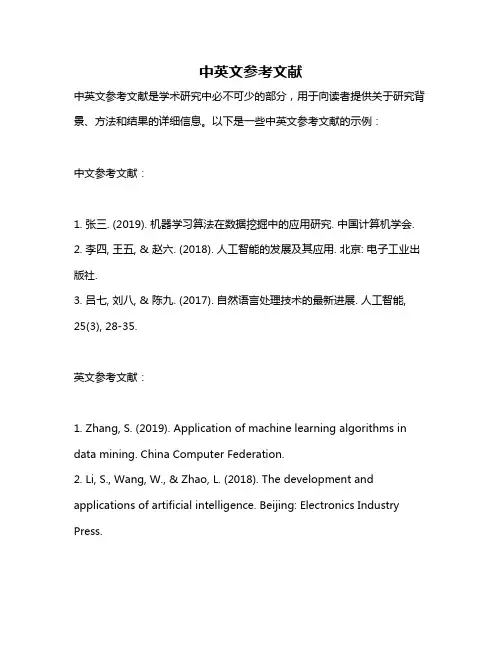
中英文参考文献
中英文参考文献是学术研究中必不可少的部分,用于向读者提供关于研究背景、方法和结果的详细信息。
以下是一些中英文参考文献的示例:
中文参考文献:
1. 张三. (2019). 机器学习算法在数据挖掘中的应用研究. 中国计算机学会.
2. 李四, 王五, & 赵六. (2018). 人工智能的发展及其应用. 北京: 电子工业出版社.
3. 吕七, 刘八, & 陈九. (2017). 自然语言处理技术的最新进展. 人工智能, 25(3), 28-35.
英文参考文献:
1. Zhang, S. (2019). Application of machine learning algorithms in data mining. China Computer Federation.
2. Li, S., Wang, W., & Zhao, L. (2018). The development and applications of artificial intelligence. Beijing: Electronics Industry Press.
3. Lyu, Q., Liu, B., & Chen, J. (2017). The latest advances in natural language processing technology. Artificial Intelligence, 25(3), 28-35.。
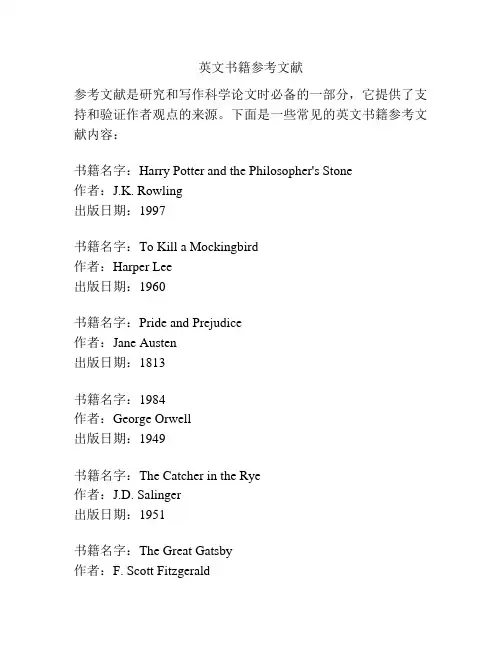
英文书籍参考文献参考文献是研究和写作科学论文时必备的一部分,它提供了支持和验证作者观点的来源。
下面是一些常见的英文书籍参考文献内容:书籍名字:Harry Potter and the Philosopher's Stone作者:J.K. Rowling出版日期:1997书籍名字:To Kill a Mockingbird作者:Harper Lee出版日期:1960书籍名字:Pride and Prejudice作者:Jane Austen出版日期:1813书籍名字:1984作者:George Orwell出版日期:1949书籍名字:The Catcher in the Rye作者:J.D. Salinger出版日期:1951书籍名字:The Great Gatsby作者:F. Scott Fitzgerald出版日期:1925书籍名字:Moby-Dick作者:Herman Melville出版日期:1851书籍名字:Jane Eyre作者:Charlotte Brontë出版日期:1847书籍名字:The Lord of the Rings作者:J.R.R. Tolkien出版日期:1954书籍名字:The Bible作者:Various出版日期:Various这些书籍都是经典的文学作品,在世界范围内享有很高的声誉和影响力。
它们涵盖了各种文学流派和主题,从奇幻小说到科幻小说,从社会评论到历史小说,从中世纪到未来,它们提供了对不同时代和文化背景的深入洞察。
这些书籍的作者都是非凡的文学大师,他们通过精湛的笔触和故事情节刻画出了令人难以忘怀的人物形象和引人入胜的剧情。
通过这些作品,读者可以沉浸在一个全新的世界中,探索和思考关于人性、社会和存在的问题。
这些书籍也被广泛翻译成各种语言,让全球读者都能享受到它们带来的魅力。
无论是学术研究还是纯粹的娱乐阅读,这些书籍都是不可或缺的参考。
它们为读者提供了不同的观点和经验,帮助读者扩展思维和视野。
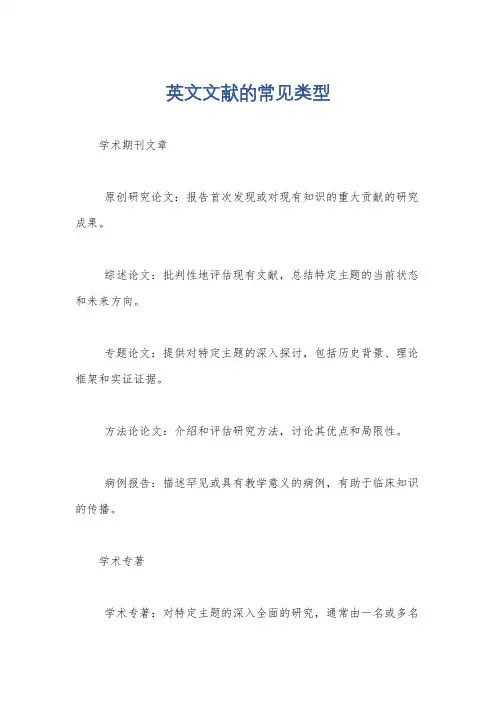
英文文献的常见类型
学术期刊文章
原创研究论文:报告首次发现或对现有知识的重大贡献的研究成果。
综述论文:批判性地评估现有文献,总结特定主题的当前状态和未来方向。
专题论文:提供对特定主题的深入探讨,包括历史背景、理论框架和实证证据。
方法论论文:介绍和评估研究方法,讨论其优点和局限性。
病例报告:描述罕见或具有教学意义的病例,有助于临床知识的传播。
学术专著
学术专著:对特定主题的深入全面的研究,通常由一名或多名
学者撰写。
编著:由多位作者撰写的章节集,涵盖特定领域的各个方面。
手册:提供特定学科或主题的实用指南,通常由多位专家撰写。
会议论文集
会议论文:在学术会议上发表的论文,通常包含正在进行的研
究或新发现的摘要。
会议论文集:收集并发表在特定会议上发表的论文。
学位论文
硕士论文:对特定课题进行深入研究,通常作为硕士学位的一
部分撰写。
博士论文:对特定课题进行原创性研究,通常作为博士学位的
一部分撰写。
技术报告
技术报告:记录研究成果、项目进展或技术发展的正式文件。
白皮书:阐述特定技术问题或解决方案的综合报告。
其他类型
评论:对已发表研究或其他出版物的批判性评估。
访谈:对专家或主题专家进行正式采访,以收集见解和信息。
文献综述:对特定主题的已发表文献进行系统性的总结和分析。
传记:个人的生活和职业的详细描述。
自传:个人撰写的自己生活的叙述。
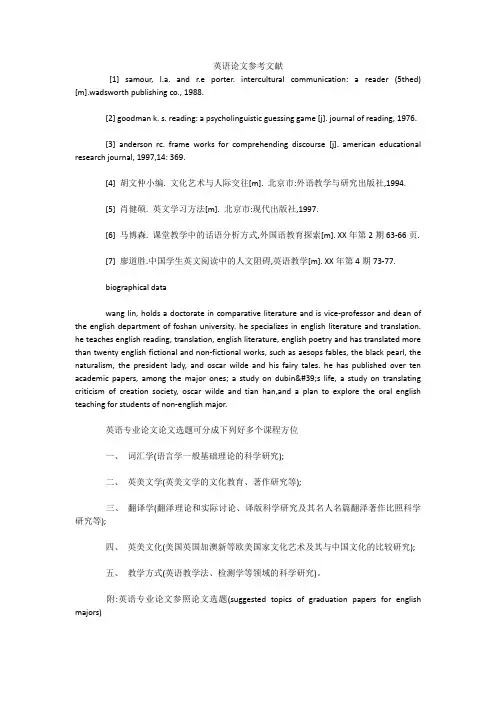
英语论文参考文献[1] samour, l.a. and r.e porter. intercultural communication: a reader (5thed) [m].wadsworth publishing co., 1988.[2] goodman k. s. reading: a psycholinguistic guessing game [j]. journal of reading, 1976.[3] anderson rc. frame works for comprehending discourse [j]. american educational research journal, 1997,14: 369.[4] 胡文仲小编. 文化艺术与人际交往[m]. 北京市:外语教学与研究出版社,1994.[5] 肖健硕. 英文学习方法[m]. 北京市:现代出版社,1997.[6] 马博森. 课堂教学中的话语分析方式,外国语教育探索[m]. XX年第2期63-66页.[7] 廖道胜.中国学生英文阅读中的人文阻碍,英语教学[m]. XX年第4期73-77.biographical datawang lin, holds a doctorate in comparative literature and is vice-professor and dean of the english department of foshan university. he specializes in english literature and translation. he teaches english reading, translation, english literature, english poetry and has translated more than twenty english fictional and non-fictional works, such as aesops fables, the black pearl, the naturalism, the president lady, and oscar wilde and his fairy tales. he has published over ten academic papers, among the major ones; a study on dubin's life, a study on translating criticism of creation society, oscar wilde and tian han,and a plan to explore the oral english teaching for students of non-english major.英语专业论文论文选题可分成下列好多个课程方位一、词汇学(语言学一般基础理论的科学研究);二、英美文学(英美文学的文化教育、著作研究等);三、翻译学(翻泽理论和实际讨论、译版科学研究及其名人名篇翻泽著作比照科学研究等);四、英美文化(美国英国加澳新等欧美国家文化艺术及其与中国文化的比较研究);五、教学方式(英语教学法、检测学等领域的科学研究)。
几个免费英文文献的网站推荐几个免费英文文献的网站2007-06-14 9:48Update: 2011-06-26①:学术英文资料NCBI美国国家生物技术中心简介:生物、医学、药学等友情提示1:PMC搜索入口在Search下拉列表中找到,可以找到全文的免费文献友情提示2:其它入口也有部分文献可查看全文,如PubMed,右上角会有“Full-Text Article”HighWire Press简介:综合类;斯坦福大学下属的出版机构;友情提示:部分免费,标识有“This article is FREE”; Science简介:科学杂志官方网站友情提示:免费注册后,可以下载1997年以前的全文;注册有点繁琐,但是内容都可以随意填写,不过,一定要记住自己先前大致的填写内容,否则通不过最后的一个验证;Nature简介:自然杂志官方网站,有一些Full Text的在线发表的论文;ScienceDirect简介:综合期刊、论文;友情提示:仅带绿框的文章可全文浏览;沃顿知识在线简介:商业,金融经济类为主;分中、英文两个版本;Marxists 简介:文史类;有中文版;友情提示:一切与马克思主义挨边的资料人、事件、国家,都可以在这儿找;比如可以找到列宁、毛泽东、鲁迅等的生平和着作,还有法国大革命、古巴导弹危机……;literature简介:综合类;类似于一个文献搜索的搜索引擎;友情提示:“Free Full Text”一栏值得关注,提供了一些全文免费文献的搜索入口;②:普通英文资料Wikipedia维基百科简介:英文大百科全书;查单个词条十分方便;友情提示1:适合于查找资料性的东西,比如,电冰箱的诞生史、微软的概况、红楼梦的简评和人物分析等Many books简介:免费的英文小说下载,都是无版权争议的,即20世纪之前的经典,提供多种格式;友情提示:在Search框里输入内容后,直接回车即可,没设置搜索按钮;Archive简介:资源丰富,被称为网络的“黑洞”;友情提示:要找某个网站的历史网页,可以到这儿来碰碰运气;Encyclopedia简介:英文大百科全书,类似于Wikipedia;Answers简介:搜索引擎Answers做的百科;About简介:类似一个门户网站,可以找找分类文章;其它未整理:。
英文文献的参考文献格式英文参考文献的标准格式有哪些呢?第一,期刊(Journal)是最常见的参考文献类型。
它一般依次包括:作者,文章的题目,期刊名称,发表年份,卷号和页码。
譬如:Author 1,A. B.; Author 2, C. D. Title of the article. Abbreviated Journal name Year ,volume ,page range ,DOI or other identifier .Available online :URL(accessed on Dav Month Year).当然,页码也可以由DOI,文章编号(Artice Number)代替。
第二,参考文献如果是书(Book),则一般要列出:作者,书名,出版社,出版社地点(包括城市和国家),年份,页码。
譬如:Dyckman,Thomas R.,and Stephen A.Zeff."Accounting Research:Past,Present,and Future."Abacus 51.4(2015):511-524.第三,而如果引用的是书中的某个章节(Chapter),需要流出的信息有:作者,章节的题目,书名,编辑,出版社,出版社地点(包括城市和国家),年份,卷号,页码。
譬如:Author 1,A. ;Author 2, B. Title of the chapter .Tn Book Title ,2nd ed .;Editor 1, A.,Editor 1, B.,Eds.;Publisher Location ,Country,2007;Volume 3 ,pp.154-196.Author 1,A. ;Author 2, B. Title of the chapter .Tn Book Title ,2nd ed .;Editor 1, A.,Editor 1, B.,Eds.;Publisher Location ,Country,2007;Volume 3 ,pp.154-196.第四,而如果引用的文献是还没有发表的,则需要依次给出以下信息:作者,文章题目,期刊名称和阶段。
英文文献顺序英文文献顺序是指在论文中引用英文文献时,需要按照一定的顺序排列。
正确的顺序可以使论文更加清晰、易懂,有助于提高论文的可读性和可引用性。
以下是英文文献顺序的具体规则:1. 按照作者姓氏的字母顺序排列。
如果有多个作者,就按照第一作者的姓氏字母顺序排列。
2. 如果多篇文献的第一作者的姓氏首字母相同,则按照第一作者的名字的字母顺序排列。
3. 如果还是无法区分文献的先后顺序,则按照文献的发表年份进行排列,较早发表的排在前面。
4. 如果发表年份相同,可以依据期刊的名称先后顺序进行排列。
在排列文献顺序时,应该注意以下几点:1. 只需要按照第一作者的姓氏进行排序,其他作者的名字或缩写并不影响顺序。
2. 在期刊名称不同时,可以将其缩写并按照缩写的字母顺序排列。
3. 如果多篇文献的作者和发表年份都相同,则可以通过添加字母或数字的方式进行区分,并按照这些标识进行排列。
对于文献引用的格式,可以采用以下方式:(1)直接在句子中引用文献,例如:“Johnson and Smith(2005)指出……”。
需要注意在年份之后加上逗号。
(2)在括号中引用文献,例如:“研究表明,心理健康问题与工作压力密切相关(Xu,2010)”。
需要注意在作者的姓氏与年份之间加上逗号。
(3)当引用同一作者的多篇文献时,可以在文献后加上小写字母进行区分,如“…(Johnson,2005a;Johnson,2005b)”。
总之,正确的英文文献顺序是科学论文写作中必不可少的一部分,可以提高论文的严谨性和可读性。
在进行文献引用时,也需要遵循一定的格式要求,以使引用更加规范、准确。
share with 各位会计、财务专业的同学...(P.S.读英文期刊绝对是体力活...开读前一定要吃好睡好...)这些是会计学的基础文献,是所有其他文献的参考文献~~~经典文献(The 100 articles with the highest citation index-until 1996)参考:Lawrence D. Brown, 1996, “Influential Accounting Articles, Individuals, Ph. D Granting Institutions and Faculties; A Citational Analysis”, Accounting, Organizations and Society, Vol.21, NO.7/8, P726-7281. Ball, R. an d Brown, P., 1968, “An Empirical Evaluation of Accounting Income Numbers”, journal of Accounting Research, Autumn, pp. 159-1781. 2.Watts R.L., Zimmerman J., 1978, “Towards a Positive Theory of theDetermination of Accounting Standards”, The Accounting Review, pp. 112-1342. 3.Healy P.M, 1985, “The Effect of Bonus Schemes on Accounting Decisions”,Journal of Accounting and Economics, April, 85-1073.Hopwood A. G., “Towards an Organizational Perspective for the Study ofAccounting and Information Systems”, Accounting, Organizations and Society (No.1, 1978) pp. 3-144.Collins, D. W., Kothari, S. P., 1989, “An Analysis of Intertemporal andCross-Sectional Determinants of Earnings Response Coefficients”, journal ofAccounting & Economics, pp. 143-1815.EastonP.D, Zmijewski M.E, 1989, “Cross-Sectional Variation in the Stock MarketResponse to Accounting Earnings Announcements”, Journal of Accou nting andEconomics, 117-1416.Beaver, W. H., 1968, “The Information Content of Annual EarningsAnnouncements”, journal of Accounting Research, pp. 67-927.Holthausen R.W., Leftwich R.W., 1983, “The Economic Consequences ofAccounting Choice: Implications of Costly Contracting and Monitoring”, journal of Accounting & Economics, August, pp77-1178.Patell J.M, 1976, “Corporate Forecasts of Earnings Per Share and Stock PriceBehavior: Empirical Tests. Journal of Accounting Research, Autumn, 246-2769.Brown L.D., Griffin P.A., Hagerman R.L., Zmijewski M.E, 1987, “An Evaluation ofAlternative Proxies for the Market’s Assessment of Unexpected Earnings”, Journal of Accounting and Economics, 61-8710.Ou J.A., Penman S.H., 1989, “Financial Statement Analysis a nd the Prediction ofStock Returns”, Journal of Accounting and Economics, Nov., 295-32911.William H. Beaver, Roger Clarke, William F. Wright, 1979, “The Associationbetween Unsystematic Security Returns and the Magnitude of Earnings ForecastErrors,” Journa l of Accounting Research, 17, 316-340.12.Burchell S., Clubb C., Hopwood, A., Hughes J., Nahapiet J., 1980, “The Roles ofAccounting in Organizations and Society”, Accounting, Organizations and Society, No.1, pp. 5-2813.Atiase, R.K., 1985, “Predisclosure Info rmation, Firm Capitalization, and SecurityPrice Behavior Around Earnings Announcements”, journal of Accounting Research, Spring, pp.21-36.ler P., O'Leary T., 1987, “Accounting and the Construction of the GovernablePerson”, Accounting, Organizations and Society, No. 3, pp. 235-26615.O'Brien P.C., 1988, “Analysts' Forecasts As Earnings Expectations”, journal ofAccounting & Economics, pp.53-8316.Bernard, V. L., 1987, “Cross-Sectional Dependence and Problems in Inference inMarket-Based Accounting Researc h”, Journal of Accounting Research, Spring, pp.1-4817.Brown L.D., Griffin P.A., Hagerman R.L., Zmijewski M.E, 1987, “An Evaluation ofAlternative Proxies for the Market’s Assessment of Unexpected Earnings”, Journal of Accounting and Economics, 61-8718.Freem an, R. N., 1987, “The Association Between Accounting Earnings and SecurityReturns for Large and Small Firms”, journal of Accounting & Economics, pp.195-22819.Collins, D. W. , Kothari, S. P. and Rayburn, J. D., 1987, “Firm Size and theInformation Content of Prices with Respect to Earnings”, journal of Accounting & Economics, pp. 111-13820.Beaver, W. H., Lambert, R. A. and Morse, D., 1980, “The Information Content ofSecurity Prices, Journal of Accounting & Economics”, March, pp. 3-2821.Foster G., 1977, “Quar terly Accounting Data: Time-Series Properties andpredictive-Ability Results”, The Accounting Review, pp. 201-23222.Christie A.A., 1987, “On Cross-Sectional Analysis in Accounting Research”, journalof Accounting & Economics, December, pp. 231-25823.Loft A., 1986, “Towards a Critica1 Understanding of Accounting: The Case of CostAccounting in theU.K.”, 1914-1925, Accounting, Organizations and Society, No.2, pp.137-17024.GonedesN.J., Dopuch N., 1974, “Capital Market Equilibrium, InformationProduction, and Selecting Accounting Techniques: Theoretical Framework and Review of Empirical Work”, journal of Accounting, 48-12925.Bowen, R. M. , Noreen, E. W. and Lacey, J. M., 1981, “Determinants of theCorporate Decision to Capitalize Interest”, Journal of Accounting & E conomics, August, pp151-17926.Hagerman R.L, Zmijewski M.E, 1979, “Some Economic Determinants of AccountingPolicy Choice”, Journal of Accounting and Economics, August, 141-16127.Burchell S., Clubb, C. and Hopwood, A. G., 1985, “Accounting in its Socia1 Conte xt:Towards a History of Value Added in theUnited Kingdom”, Accounting,Organizations and Society, No. 4, pp.381-41428.Leftwich R.W, 1981, “Evidence of the Impact of Mandatory Changes in AccountingPrinciples on Corporate Loan Agreements”, Journal of Accoun ting and Economics, 3-3629.Bernard, V. L. and Thomas, J . K., 1989, “Post-Earnings Announcement Drift:Delayed Price Response or Risk Premium?”, Journal of Accounting Research, pp.1-3630.WattsR.L., Zimmerman J.L., 1979, “The Demand for and Supply of Account ingTheories: The Market for Excuses”, The Accounting Review, April, pp. 273-305 31.Armstrong J.P., 1987, “the rise of Accounting Controls in British CapitalistEnterprises”, Accounting, Organizations and Society, May, pp. 415-43632.Beaver, W. H. , Lambert, R. A. and Ryan, S. G., 1987, “The Information Content ofSecurity Prices: A Second Look”, journal of Accounting & Economics, July, pp.139-15733.Chambers, A. E., Penman, S.H, 1984, “Timeliness of Reporting and the Stock PriceReaction to Earnings Announcemen ts”, journal of Accounting Research, Spring, pp.21-4734.Collins D.W., Rozeff M.S., Dhaliwal D.S., 1981, “The Economic Determinants of theMarket Reaction to Proposed Mandatory Accounting Changes in the Oil and Gas Industry: A Cross-Sectional Analysis”, Jou rnal of Accounting and Economics, 37-71 35.Holthausen R.W., 1981, “Evidence on the Effect of Bond Covenants andManagement Compensation Contracts on the Choice of Accounting Techniques: The Case of the Depreciation Switch-Back”, journal of Accounting & Economics, March, pp. 73-10936.ZmijewskiM.E., Hagerman R.L., 1981, “An Income Strategy Approach to thePositive Theory of Accounting Standard Settings/Choice”, Journal of Accounting and Economics, 129-14937.Lev B., Ohlson J.A, 1982, “Market-Based Empirical Research in Accounting: AReview, Interpretation, and Ext ension”, Journal of Accounting Research, 249-322 38.Ou J. and Penman S.H., 1989, “Financial Statement Analysis and the Prediction ofStock Returns”, Journal of Accounting and Economics, Nov., 295-32939.Bruns Jr. W.J, Waterhouse, J., 1975, “Budgetary Control a nd OrganizationStructure”, journal of Accounting Research, Autumn, pp. 177-20340.Tinker A.M., Merino B.D., Neimark M., 1982, “The Normative Origins of PositiveTheories: Ideology and Accounting Thought, Accounting, Organizations andSociety”, No. 2, pp. 167-20041.Foster, G., 1980, “Accounting Policy Decisions and Capital Market Research”,journal of Accounting & Economics March, pp. 29-6242.Gibbins M., 1984, “Propositions About the Psychology of Professional Judgement inPublic Accounting”, Journal of Account ing Research, Spring, pp. 103-12543.Hopwood A.G, 1983, “On Trying to Study Accounting in the Contexts in which itOperates”, Accounting, Organizations and Society, No. 2/3, pp. 287-30544.Abdolmohammadi M.J., Wright A., 1987, “An Examination of the Effects ofExperience and Task Complexity on Audit Judgments”, The Accounting Review, pp.1-1345.Berry, A. J., Capps, T., Cooper, D.,Ferguson, P., Hopper, T. and Lowe, E. A., 1985,“Management Control in an Area of the NCB: Rationales of Accounting Practices ina Pub lic Enterprise”, Accounting, Organizations and Society, No.1, pp.3-2846.Hoskin, K.W., Macve R.H, 1986, “Accounting and the Examination: A Genealogy ofDisciplinary Power”, Accounting, Organizations and Society, No. 2, pp. 105-136 47.Kaplan R.S, 1984, “The Evolution of Management Accounting”, The AccountingReview, 390-34148.Libby R., 1985, “Availability and the Generation of Hypotheses in Analytica1Review”, journal of Accounting Research, Autumn, pp. 648-66749.Wilson G.P., 1987, “The Incremental Information Con tent of the Accrual and FundsComponents of Earnings After Controlling for Earnings”, the Accounting Review, 293-32250.Foster, G., Olsen, C., Shevlin T., 1984, “Earnings Releases, Anomalies, and theBehavior of Security Returns”, The Accounting Review, Octo ber, pp.574-603 51.Lipe R.C., 1986, “The Information Contained in the Components of Earnings”,journal of Accounting Research, pp. 37-6852.Rayburn J., 1986, “The Association of Operating Cash Flows and Accruals WithSecurity Returns”, Journal of Accounting Re search, 112-13753.Ball, R. and Foster, G., 1982, “Corporate Financial Reporting: A MethodologicalReview of Empirical Research”, journal of Accounting Research, pp. 161-234 54.Demski J.S, Feltham G.A, 1978, “Economic Incentives in Budgetary ControlSystems”, The Accounting Review, 336-35955.Cooper D.J, Sherer M.J, 1984, “The Value of Corporate Accounting Reports:Arguments for a Political Economy of Accounting”, Accounting, Organizations and Society, No.3, 207-23256.Arrington, C. E., Francis J.R., 1989, “Letting the Chat Out of the Bag:Deconstruction privilege and Accounting Research”, Accounting Organization and Society, March, pp. 1-2857.Fried, D., Givoly, D., 1982, “Financial Analysts' Forecasts of Earnings: A BetterSurrogate for Market Expectations”, journal of Accounting & Economics, October, pp. 85-10758.Waterhouse J. H., Tiessen P., 1978, “A Contingency Framework for ManagementAccounting Systems Research”, Accounting, Organizations and Society, No.3,pp.65-7659.Ashton, R .H., 1974, “Experimental Study of In ternal Control Judgment journal ofaccounting Research”, 1974, pp. 143-15760.Collins D. W., Dent, W. T., 1979, “The Proposed Elimination of Full Cost Accountingin the Extractive Petroleum Industry: An Empirical Assessment of the MarketConsequences”, journ al of Accounting & Economics, March, pp. 3-4461.Watts R.L., Leftwich, R. W., 1977, “The Time Series of Annual Accounting Earnings,journal of Accounting Research”, Autumn, pp. 253-27162.Otley D.T, 1980, “The Contingency Theory of Management Accounting:Achievement and Prognosis”, Accounting, Organizations, and Society, NO. 4,413-42863.Hayes D.C, 1977, “The Contingency Theory of Managerial Accounting”, TheAccounting Review, January, 22-3964.Bea ver, W. H. ,Griffin, P. A. and Landsman, W. R., 1982, “The IncrementalInformation Content of Replacement Cost Earnings”, Journal of Accounting &Economics, July, pp. 15-3965.Libby R., Lewis B.L., 1977, “Human Information Processing Research in Accounting:The State of the Art”, Accounting, Organizations and Society, No.3, pp. 245-268 66.Schipper W., Thompson R., 1983, “The Impact Mergers-Related Regulations onthe Shareholders of Acquiring Firms”, Journal of Accounting Research, 184-221 67.Antle, R., Smith, A., 1986, “An Empirical Investigation of the Relative PerformanceEvaluation of Corporate Executives”, journal of Accounting Research, spring,pp.1-39.68.GonedesN.J., Dopuch N., Penman S.H., 1976, “Disclosure Rules,Information-Production, and Capital Market Equilibrium: The Case of ForecastDisclosure Rules”, Journal of Accounting Research, 89-13769.Ashton, A. H. and Ashton, R. H., 1998, “Sequential Belief Revision in Auditing”, TheAccounting Review, October, pp. 623-641rcker D.F, 1983, “The Association Be tween Performance Plan Adoption andCorporate Capital Investment”, Journal of Accounting and Economics, 3-3071.McNichols M., Wilson G.P., 1988, “Evidence of Earnings Management from theProvision for Bad Debts”, journal of Accounting Research, pp.1-3172.Tomk ins C., Groves R., 1983, “The Everyday Accountant and Researching HisReality”, Accounting, Organizations and Society, No 4, pp361-37473.Dye R.A, 1985, “Disclosure of Nonproprietary Information”, Journal of AccountingResearch, 123-14574.Biddle, G. C. and Li ndahl F. W., 1982, “Stock Price Reactions to LIFO Adoptions:The Association Between Excess Returns and LIFO Tax Savings”, Journal ofAccounting Research, 1982, pp. 551-58875.Joyce E.J., 1976, “Expert Judgment in Audit Program Planning”, journal ofAccounting Research, pp. 29-6076.Kaplan R.S, 1983, “Measuring Manufacturing Performance: A New Challenge forManagerial Accounting Research”, The Accounting Review, 686-70577.Ball R., 1972, “Changes in Accounting Techniques and Stock Prices”, journal ofAccounting Research, Supplement, pp. 1-3878.Ricks W.E, 1982, “The Market’s Response to the 1974 LIFO Adoptions”, Journal ofAccounting Research, 367-38779.Albrecht, W. S., Lookabill L. L., McKeown, J.C., 1977, “The Time-Series Propertiesof Annual Earnings”, journal of Accounting Research, Autumn, pp. 226-24480.DeAngelo L.E, 1981, “Auditor Size and Audit Quality”, Journal of Accounting andEconomics, 183-19981.Merchant K.A., 1981, “The Design of the Corporate Budgeting System: Influenceson Managerial Behavioral and Perfor mance”, The Accounting Review, October, pp.813-82982.Penman S.H, 1980, “An Empirical Investment of the Voluntary Disclosure ofCorporate Earnings Forecasts of Earnings”, Journal of Accounting Research,132-16083.Simunic D., 1980, “The Pricing of Audit Services: Theory and Evidence”, Journal ofAccounting Research, 161-19084.Waller W. S., Felix Jr. W.L., 1984, “The Auditor and Learning from Experience:Some Conjectures”, Accounting, Organizations and Society, No. 3, pp. 383-408 85.Dyckman T.R, Smith A.J, 1979, “Financial Accounting and Reporting by Oil and GasProducing Companies: A Study of Information Effects”, Journal of Accounting and Economics, 45-7586.Holthausen R.W., Verrecchia R.E., 1988, “The Effect of Sequential InformationReleases on the Variance of Price Changes in an Intertemporal Multi-Asset Market”, journal of Accounting Research, Spring, pp.82-10687.Hopwood A. G., 1978, “Towards an Organizational Perspective for the Study ofAccounting and Information Systems”, Accounting, Organizations and Society, No.1, pp. 3-1488.Leftwich R.W, 1983, “Accounting Information in Private Markets: Evidence fromPrivate Lending Agreements”. The Accounting Review, 23-4289.Otley D.T, 1978, “Budget Use and Managerial Performance”, Journal of AccountingResearch, Spring, 122-14990.Griffin, 1977, “The time-series Behavior of Quarterly Earnings: PreliminaryEvidence”, Journal of Accounting Research, spring, 71-8391.Brownell P., 1982, “The Role of Accounting Data in Performance Evaluation,Budgetary Participation, and Organizational Effectiveness”, journal of Accounting Research, Spring, pp. 12-2792.Dhaliwal D.S, Salamon G.L, Smith E.D, 1982, “The effect of Owner Vs ManagementControl on the Choice of Accounting and Economics”, 41-5393.Hopwood A.G., 1972, “An Empirical Study of the Role of Accounting Data inPerformance Evaluation”, journal of Accounting Research, pp. 156-18294.Foster, G., 1981, “Intra-Industry Information Transfers Associated with EarningsReleases”, journal of Accounting & Economics, December, pp. 201-23295.Chua, W. F., 1986, “Radical Developments in Accounting Thought”, TheAccounting Review, October, pp601-63296.Hughes P.J., 1986, “Signalling by Direct Disclosure Under Asymmetric Information”,journal of Accounting & Economics, June, pp. 119-14297.Kinney W.R. Jr., 1986, “Audit Technology and Preference for Auditing Standards”,Journal of Accounting and Economics, 73-8998.Titman S., Trueman B., 1986, “Information Quality and the Valuation of NewIssues”, journal of Accounting& Economics, pp. 159-17299.Wilson G.P., 1986, “The Relative Information Content of Accruals andCash Flows: Combined Evidence at the Announcement and Annual Report Release Date”, Journal of Accounting Research, 165-203。
十大英文论文文献数据库(1)Wiley InterScience(英文文献期刊)评测:Wiley InterScience收录了360多种科学、工程技术、医疗领域及相关专业期刊、30多种大型专业参考书、13种实验室手册的全文和500多个题目的Wiley学术图书的全文。
其中被SCI收录的核心期刊近200种。
期刊具体学科划分为:Business, Finance & Managemen、Chemistry (化学)、Computer Science、Earth Science、Education、Engineering、Law、Life and Medical Sciences、Mathematics and Statistics ],、Physics、Psychology。
(2) IEEE (英文文献期刊)评测:IEEE会员总数2001年比2000年增加3.1%,达到377342人,其中学生会员为65669人,增长12.6%。
随着人们的信息越来越多地来自Internet,IEEE需要为会员提供更加完善和全面的电子信息产品和服务。
(3) EBSCO(英文文献期刊)评测:收录了三千多种索引、文摘型期刊和报纸,其中近三千种全文刊。
数据库涉及国际商务、经济学、经济管理、金融、会计、劳动人事、银行等的主题范围,适合经济学、工商管理、金融银行、劳动人事管理等专业人员使用。
数据库中有较著名" Walls Street Journal)、""Harvard Business Review、" Business Week、Fortune、Country Reports、American Banker、Forbes、The Economist等报刊。
该数据库从1990年开始提供全文,题录和文摘则可回溯检索到1984年,数据库每日更新。
(4) (umi)ProQuest博士论文全文,是UMI公司的一个分库(我分析之后得来的。
英文专著参考文献格式举例参考文献是学术研究的重要组成部分,它为研究提供了有力的支持和参考。
在写英文专著时,适当引用相关的参考文献是必不可少的,下面是一些英文专著参考文献格式举例:1. 书籍:Smith, John. (2021). "The Impact of Climate Change on Global Ecosystems." Cambridge University Press.这是一本由约翰·史密斯(John Smith)撰写的关于气候变化对全球生态系统影响的书籍,出版商为剑桥大学出版社(Cambridge University Press)。
2. 期刊文章:Brown, Mary, et al. (2020). "The Role of Artificial Intelligence in Healthcare." Journal of Medical Research, vol. 45, no. 3, pp. 123-135.这篇期刊文章由玛丽·布朗(Mary Brown)等人撰写,题为“人工智能在医疗领域中的作用”,发表于《医学研究杂志》(Journal of Medical Research),第45卷,第3期,页码为123-135。
3. 学位论文:Johnson, David. (2019). "The Effects of Social Media onAdolescent Mental Health." Unpublished doctoral dissertation, Harvard University.这是一篇由大卫·约翰逊(David Johnson)撰写的关于社交媒体对青少年心理健康影响的学位论文,未发表,毕业于哈佛大学。
4. 网络资源:World Health Organization. (2020). "COVID-19: Guidelines for Public Health Measures." Available at:https://www.who.int/emergencies/diseases/novel-coronavirus-2019/phm-measures.这是世界卫生组织(World Health Organization)关于COVID-19公共卫生措施指南的网络资源,可在https://www.who.int/emergencies/diseases/novel-coronavirus-2019/phm-measures上找到。
英文翻译Chapter One Introduction1.1 Background and SignificanceODE development, the formation of many disciplines are closely linked, for example, geometry branch of mathematics, physics, chemistry, biology, economics and even electronic technology, aerospace, etc. - from the development of ordinary differential equations profound and important influence, particularly the development of computer applications and theoretical study of ordinary differential equations to provide a more powerful tool. To solve practical mathematical problems of many, it is necessary by the inherent characteristics of the relationship between law and observational studies of the actual object seize the principal contradiction and establish a mathematical model reflecting the real problems while on the mathematical model of solving problems, ordinary differential equations is the most important knowledge tools. So to continue to explore application ordinary Differential Equations in mathematical modeling and still it has important academic value and its profound practical significance.Currently, there are many aspects of the research scholars, for example, Zhu Mei ling in "too far Urban V ocational College News" briefly describes the process of development and mathematical modeling of ordinary differential equations and ordinary differential equations in Mathematical Modeling Some applications, and the status and role of mathematical modeling in mathematics teaching made some prospects; Wang Ying xia in "intelligence" describes the development period December 2011 ordinary differential equations, mathematical modeling characteristics; focuses on ordinary differential equations combined with each other and mathematical modeling, specific examples relevant in different areas, summarized the importance of ordinary Differential Equations in mathematical modeling; Zhao Jia lin in "China Education innovation Herald" 2009 the 1 period describes the objective is an important relationship between the number of mathematical models.Central subject areas of mathematics ODE has been nearly 300 years of development history, in order to seek to resolve a similar fate during the freefall drop as a function of distance and time; this kind of practical research rocket in the air when the flight path, etc. question often asked us to find that one or more unknowns equations certain conditions, in order to solve such practical problems resulting in a differentialequation. the equation contains the unknown function and unknown function called derivative or differential equations . differential equations is generated in the process of dealing with practical problems, the study of differential equations and facilitate the resolution of practical problems, but also to promote the development of other disciplines.1.2 The main content of this paperBased on the mathematical model and the introduction of ordinary differential equations in mathematical modeling applied ordinary differential equations, such as: the general theory of differential equations, existence and uniqueness, stability of differential equations, ordinary differential equation model population, diet mathematical models, chemical plant ventilation issue model. find theoretical study applied mathematics to solve practical problems in the process, while setting up and solving all mathematical models, are designed to better guide the application of mathematical theory in real life. ordinary Differential Equations ordinary Differential Equations and the emergence of wide application in mathematical modeling, is to better enable ordinary people to understand and use mathematical theory, to better solve practical problems. the conversion to a knowledge-based theory of sublimation capacity by type, highlight Differential Equations and applications in mathematical modeling and strive to make a significant contribution to the outstanding in various fields.Application of Chapter II Ordinary Differential Equations in Mathematical Modeling ODE originate from production practice, develop and gradually improve, with differential equations to solve practical problems is generally divided into the following steps in solving many problems in science and technology: First, the analysis and propose practical problems; second, according to the problem law establishing differential equations (known as the mathematical model); third, the solution of this differential equation or qualitative analysis; the fourth, then the final solution of the equation (or nature) explain and predict the development of mathematical modeling Yes. . the main way to solve practical problems of differential equations modeling approach described below:Modeling is an important method of differential equations and applied mathematical modeling, mathematical description of many practical problems would lead to solving the problem of definite solution of differential equations. The solution of the problem given all sorts of practical problems of differential equations, ingeneral, you can press the following steps :(1) establish the corresponding mathematical model based on the actual problem - - differential equations (group).(2) research and solving the mathematical model, including the characteristics of the solution.(3) the use of solution results obtained, in the form of numerical solution, qualitative research and analysis, interpretation of practical problems, in order to predict and describe certain phenomena, and even social phenomena specific characteristics. (4) modify the model if necessary, or to explore the matter further.Common methods listed equations are:(1) according to the law column equation, in mathematics, mechanics, physics, chemistry and other disciplines in many natural phenomena have been satisfied by the law for people to grasp, and directly described by differential equations. We often use these laws on certain practical issues Equations are listed.(2) micro-element analysis method and the integral method takes an arbitrary region There are many phenomena in nature rule is satisfied by the relationship between the infinitesimal variables expressed. For such problems, the use of micro-element analysis, a number of variables (independent variables with unknown function) by the known rules the relationship between the differential element, and then get the differential equation by finding the limits of the method, or equivalently, by integrating the regional approach to establish any differential equations.(3) simulation approximationIn biology, economics and other disciplines, many phenomena that meet the law is not clear, and quite complicated, and therefore need to know the actual data or a large number of experimental data, put forward various hypotheses. Under certain assumptions, given the actual phenomenon meet the objective law, then list the appropriate differential equations based on mathematical methods in modeling the actual process of differential equations, are often integrated application of the method. In either application modeling methods, usually based on the actual issues in the case, make certain assumptions and simplified, and the theory or model results were compared with the actual situation verified and compared in order to modify the model to make it more accurate description to solve practical problems and thus achieve the purpose of forecasting.Mathematical Model 2.1 weight loss1. The question raisedWith the improvement of people's living standards, ordinary people in diet fitness wind malpractice, but many of the weight loss methods, food, beverages almost let people know what to do, some not achieve the desired effect, or even adverse consequences, so that newspapers, television, radio constantly remind people: to lose weight should be careful to ask how to build a mathematical model of weight loss.? 2. AnalysisAll races of people of different gender has its own weight standards, but for Asians, 20% more than the standard weight considered obese. "Obesity," a sense that too much fat that exceed the standard. If human ingestion of food containing excessive heat, the body of these excess calories will be converted to fat in fat increase. in order to lose weight should eat or not eat it seems, but in order to sustain life, it must consume some energy (heat ) maintain basic metabolism, work, learning and physical exercise also burns calories. Therefore, the weight should be based on proper analysis of diet, metabolism, physical exercise and work on the basis of these relationships, select the appropriate method of mathematical model of weight loss thus we must start to build.3. The model assumes(1) Let someone daily caloric intake from food is aJ, where bJ for metabolism (ie automatic consumption), and working life must be consumed per day per kg of body weight J calories, physical activity per kg body weight per day J consumed calories;(2) a person stored as fat calories of white percent effective, while 1kg of fat calories is 42000J;(3) Let the weight of time t continuously differentiable functionChapter summaryThrough theoretical and basic study on the stability of differential equations, the study of the basic theory and practical weight loss problem mathematical models, to illustrate the application of mathematics has penetrated into all fields or industries increasingly rely on mathematics. With the social and the development of technology, both in the various disciplines, and in the industry have emerged a large number of urgent need of people to study and resolve the actual problem, which requires the relevant staff the flexibility to use thinking and mathematical knowledge to solve problems encountered, so that the greatest social and economic benefits achieved.第一章绪论1.1背景及意义常微分方程的发展、形成与许多学科都有着密切的联系,例如几何学、物理学、化学、生物学、经济学甚至电子科技、航天航空等.为数学的分支学科—常微分方程的发展起着深刻而重要的影响,特别是计算机的发展更为常微分方程的应用及理论研究提供有力的工具.数学若想解决实际的许多问题,就要通过观察研究实际对象的特征和内在的关系规律,抓住问题的主要矛盾,建立起反映实际问题的数学模型.而在数学模型求解的问题上,常微分方程是最重要的知识工具.因此继续探讨研究常微分方程在数学建模中的应用依然是有着及其重要的学术价值和及其深刻的现实意义.目前,已有很多学者对此方面进行了研究,例如,朱美玲在《太远城市职业技术学院报》中简要介绍了常微分方程的发展和数学建模的过程以及常微分方程在数学建模中的一些应用,并对数学建模在数学教学中的地位和作用作了一些展望;王英霞在《才智》2011年12期中介绍常微分方程的发展、数学建模的特点;重点介绍了常微分方程与数学建模相互结合,在不同的领域中的相关的具体例子,总结常微分方程在数学建模中的重要性;赵家林在《中国科教创新导刊》2009年第1期中描述了客观是的数量关系的一种重要数学模型.数学领域的中心学科常微分方程至今已有近300 年的发展历史,为了寻求、解决类似自由落体下落过程中下落距离和时间的函数关系;研究火箭在空中飞行时的飞行轨道等这类实际性的问题,往往就要求我们找到满足某些特定条件的一个或多个未知数方程,为了解决这类实际问题从而产生了微分方程.把含有未知函数及未知函数导数或微分的方程称之为微分方程.微分方程是在处理实际问题的过程中产生的,微分方程的研究又促进实际问题的解决,同时也促进其他学科的发展.1.2本文研究的主要内容本文通过对常微分方程、数学模型、以及常微分方程在数学建模中应用的介绍,如:微分方程的一般理论、微分方程解的存在惟一性、微分方程的稳定性问题、人口模型、减肥的数学模型、化工车间的通风问题模型等.发现应用数学理论研究解决实际过程中的问题.而一切数学模型的建立和求解,都是为了更好的应用数学理论指导实际生活.常微分方程的出现以及常微分方程在数学建模中的广泛应用,就是为了更好地使普通人理解并利用数学理论,更好的解决实际中的问题.把理论升华为由知识型向能力型转化,突显微分方程以及微分方程在数学建模中的应用,努力在各个领域做出突出重大贡献.第二章常微分方程在数学建模中的应用常微分方程来源于生产实践,在解决科学技术的许多问题中发展并逐步完善,用微分方程解决实际问题一般分为以下几步:第一,实际问题的分析及提出;第二,根据问题的规律建立微分方程(称为建立数学模型);第三,解此微分方程或对方程进行定性分析;第四,最后再用方程的解(或性质)解释并预测问题的发展.数学建模是微分方程解决实际问题的最主要的途径.下面说明建模方法: 微分方程建模是数学建模的重要方法与应用,许多实际问题的数学描述将导致求解微分方程的定解问题.把形形色色的实际问题化微分方程的定解问题,大体上可以按以下几步:(1)根据实际问题建立对应的数学模型———微分方程(组).(2) 求解与研究这一数学模型,包括分析解的特征.(3)利用解得结果,解的形式和数值,进行定性研究与分析,解释实际问题,从而预测和描述某些现象,甚至社会现象中的特定特质.(4)必要时修改模型或对问题作进一步探讨.列方程常见的方法有:(1)按规律列方程,在数学、力学、物理、化学等学科中许多自然现象所满足的规律已为人们所掌握,并直接由微分方程进行描述.我们常利用这些规律对某些实际问题列出微分方程.(2)微元分析法和任意区域上取积分的方法自然界中有许多现象所满足的规律是通过变量的微元之间的关系式来表达的.对于这类问题,利用微元分析法,通过已知的规律建立一些变量( 自变量与未知函数) 的微元之间的关系式,然后再通过求极限的方法得到微分方程,或等价地通过任意区域上求积分的方法来建立微分方程.(3)模拟近似法在生物、经济等学科中,许多现象所满足的规律并不清楚,而且相当复杂,因而需要了解实际资料或大量的实验数据,提出各种假设.在一定的假设前提下,给出实际现象所满足的客观规律,然后根据适当的数学方法列出微分方程.实际的微分方程建模过程中,也往往是上述方法的综合应用.不论应用哪种建模方法,通常要根据实际问题中的情况,作出一定的假设与简化,并把模型的理论或计算结果与实际情况进行对照验证和比较,以修改模型使之更准确地描述解决实际问题并进而达到预测预报的目的.2.1 减肥的数学模型2.1.1问题的提出随着人们生活水平的提高,普通百姓中减肥健美之风日盛.但是众多的的减肥手段、食品、饮料几乎让人们不知所措,有的达不到预期的效果,甚至产生不良的后果,以致报刊、电视、广播经常提醒人们:减肥要慎重.问如何建立减肥的数学模型?2.1.2问题分析各种种族的不同性别人都有它自己体重的标准,但对亚洲人来说,超过标准体重的20%视为肥胖.“肥胖”从某种意义上说就是脂肪过多以致超过标准.如果人吸收含过多热量的食物,则人体中这些过多的热量就会转化为脂肪而使脂肪增加.为了减肥应似乎少吃或不吃,但为了维持生命,就必须消耗一定的能量(热量)维持最基本的新陈代谢,工作、学习及体育锻炼也要消耗热量.因此,减肥应基于对饮食、新陈代谢、工作及体育锻炼这些关系的正确分析基础上,选择适当的方法进行.减肥的数学模型就要由此入手来建立.2.1.3模型假设(1)设某人每天从食物中摄取的热量是aJ,其中bJ用于新陈代谢(即自动消耗),而从事工作、生活每天每kg体重必须消耗J 的热量,进行体育锻炼每天每kg体重消耗J 的热量;(2)某人以脂肪形式储存的热量的百分之白的有效,而1kg脂肪含热量是42000J;(3)设体重是时间t的连续的可微函数第三章总结本文通过对微分方程的基本理论及稳定性研究、减肥的数学模型等基本理论及实际问题的研究、说明数学的应用已渗透到各个领域,或者说各行各业日益依赖于数学.随着社会和科技的发展,无论是在各学科,还是在各行业均涌现出了大量的、亟待人们去研究和解决的实际课题.这就要求相关的工作人员能灵活地运用数学的思维方法和知识来解决所遇到的问题,从而取得的最大的社会和经济效益.。